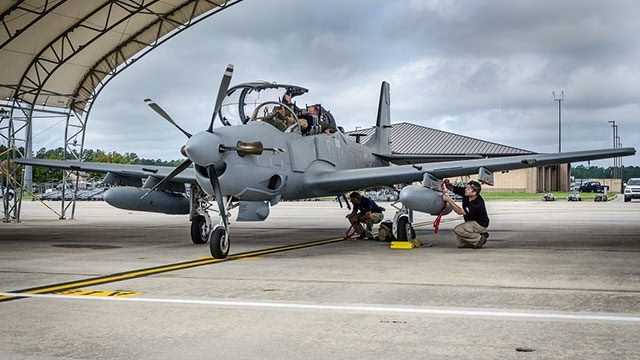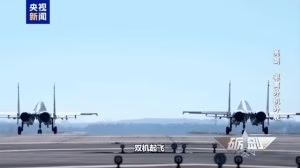Paraguay unveils A-29 Super Tucano to crush narco threats


Summary
– The advanced turboprop enhances border security with precision-guided munitions.
– Brazil-financed deal signals deeper regional defense ties.
– A-29’s proven combat record reshapes Paraguay’s military capabilities.
– Logistical challenges may test the fleet’s long-term sustainability.
Four A-29 Super Tucano light attack aircraft landed at Silvio Pettirossi Air Force Base near Asunción, Paraguay, marking the nation’s most significant defense acquisition in nearly four decades. The delivery, executed by Brazilian aerospace giant Embraer, stems from a contract signed at the Farnborough International Airshow in July 2024 for six aircraft, with the remaining two expected later this year.
Paraguayan pilots, trained in Brazil, flew the turboprops to their new home, where they were welcomed by President Santiago Peña and top military officials. The $96.6 million deal, financed through a loan from Brazil’s National Bank for Economic and Social Development, aims to bolster Paraguay’s ability to combat drug trafficking and secure its borders, particularly in the remote Gran Chaco region. This acquisition signals a leap forward for a nation with a historically underfunded air force, raising questions about its broader implications for South American security dynamics.
The ceremony at Silvio Pettirossi Air Force Base was a moment of national pride, attended by Vice President Pedro Alliana, Minister of National Defense Óscar González, and Air General Júlio Fullaondo, commander of the Paraguayan Air Force. Fullaondo described the arrival as a transformative step, emphasizing the aircraft’s role in modernizing Paraguay’s aerial capabilities.
“The A-29 Super Tucanos, equipped with state-of-the-art technology, increase our effectiveness in executing airspace surveillance missions and providing a timely response to emerging challenges,” he said, underscoring their importance for national sovereignty.
The deal includes training for eight pilots and twelve mechanics, a flight simulator, and logistical support, ensuring Paraguay can integrate the aircraft into its operations. This move comes as the country also invests in radar systems to enhance its ability to monitor its airspace, a critical need in a region plagued by illicit cross-border activities.
A-29 Super Tucano: a versatile light attack platform
The A-29 Super Tucano, developed by Embraer, is a single-engine turboprop designed for light attack, close air support, armed reconnaissance, and advanced pilot training. Powered by a Pratt & Whitney Canada PT6A-68C engine generating 1,600 horsepower, it achieves a top speed of 367 miles per hour and a range of over 900 miles, with a five-bladed Hartzell propeller optimizing efficiency.
Its rugged airframe allows operations from unpaved runways, making it ideal for Paraguay’s austere environments, such as the Gran Chaco’s rough terrain. The aircraft’s two-seat cockpit accommodates a pilot and a weapons systems officer or instructor, enhancing its versatility for both combat and training missions.
The Super Tucano’s avionics suite is a key strength, featuring a digital head-up display, a laser rangefinder, and a forward-looking infrared system for day and night operations. Its advanced data links enable real-time coordination with ground forces, critical for missions like joint terminal attack control and close air support. The aircraft can carry an array of weaponry, including 250-pound and 500-pound precision-guided bombs, 70mm rockets, and wing-mounted .50-caliber machine guns.
Recent upgrades to the A-29M standard, introduced in 2024, include enhanced data links, a helmet-mounted display, and anti-drone countermeasures, reflecting the growing threat of unmanned systems in modern conflicts. Embraer reports the A-29 has logged over 600,000 flight hours, with 60,000 in combat, across 22 air forces worldwide, underscoring its reliability.
Compared to competitors like the Textron Aviation AT-6B Wolverine, the A-29 stands out for its combat-proven track record and low operating costs, estimated at $1,000 per flight hour. The AT-6B, while equipped with similar sensors, has seen less operational use, giving the Super Tucano an edge for nations seeking a tested platform.
The A-29’s ability to integrate modern guided munitions, such as the Joint Direct Attack Munition, enhances its precision, making it a cost-effective alternative to jet fighters like the F-16, which can cost over $20,000 per hour to operate. Paraguay’s choice of the A-29 reflects its need for a versatile, affordable aircraft to address low-intensity threats without the expense of advanced fighters.
Tactical leap for Paraguay’s air force
Paraguay’s air force has long relied on a modest fleet of six Embraer EMB-312 Tucano trainers, acquired in the 1980s, which lack the sensors and weaponry needed for modern operations. The A-29 Super Tucano addresses these gaps, offering advanced capabilities for surveillance, precision strikes, and ground support.
In the Gran Chaco, a vast, sparsely populated region prone to drug smuggling and organized crime, the aircraft’s low-altitude flight capabilities and night vision systems will enable effective monitoring of illicit activities. Its loiter time, often exceeding four hours, allows for prolonged surveillance, while its precision-guided munitions reduce the risk of collateral damage in counter-narcotics missions.
The Super Tucano’s integration with ground forces will enhance Paraguay’s ability to conduct rapid-response operations, such as supporting army units targeting smuggling routes along the borders with Brazil and Bolivia. Its advanced communication systems facilitate coordination with ground-based command centers, a critical feature for joint operations.
The aircraft’s training role will also allow Paraguay to develop a skilled pilot cadre, reducing dependence on foreign programs. The inclusion of a flight simulator in the Embraer deal further supports this goal, enabling cost-effective training without expending flight hours.
South American context: a regional trend
Paraguay’s acquisition aligns it with a growing number of South American nations operating the A-29, including Brazil, Chile, Colombia, Ecuador, and Uruguay, which also signed a deal for up to six Super Tucanos in 2024. This regional trend highlights the aircraft’s appeal for addressing non-traditional threats like drug trafficking and insurgency, which dominate security concerns in Latin America.
Brazil, with over 90 A-29s, has used the aircraft extensively for border patrols and counter-narcotics operations, setting a model for Paraguay. Uruguay’s decision to replace its aging A-37B Dragonfly aircraft with Super Tucanos reflects a similar focus on modernizing for aerial patrol missions.
The deal, financed by Brazil’s development bank, underscores deepening ties between Paraguay and its larger neighbor, raising questions about regional influence. “The aircraft acquisition will bolster the strategic partnership between Brazil and Paraguay,” a spokesperson for the Brazilian National Bank for Economic and Social Development said, emphasizing its role in combating narco-terrorism.
The United States, which has supplied A-29s to countries like Colombia and Afghanistan through its Foreign Military Sales program, also plays a role in the region’s defense landscape. Paraguay’s alignment with Brazil, however, suggests a shift toward regional suppliers, potentially reducing reliance on U.S. military aid amid growing Chinese economic influence in Latin America.
Technological trends: the rise of light attack aircraft
The global popularity of light attack aircraft like the A-29 reflects a shift toward cost-effective platforms for low-intensity conflicts. Unlike high-end fighters such as the F-35, which can cost over $30,000 per flight hour, the Super Tucano’s affordability and versatility make it ideal for nations with limited budgets.
Its recent upgrades, including anti-drone capabilities and NATO-compatible data links in the A-29N variant ordered by Portugal, demonstrate its adaptability to modern threats. Embraer’s development of a side-looking airborne radar, capable of detecting small ground targets, further enhances its utility for surveillance missions.
The A-29’s rugged design, with a high fatigue life and corrosion-resistant airframe, suits operations in harsh environments like Paraguay’s Gran Chaco. Its minimal infrastructure requirements and on-condition maintenance approach reduce lifecycle costs, a critical factor for resource-constrained air forces. The aircraft’s selection by 22 air forces, including recent orders from Panama and an undisclosed African nation, reflects a broader trend toward platforms that balance capability and affordability in asymmetric warfare.
Operational history: a proven performer
The A-29 Super Tucano has a robust operational record, particularly in South America and beyond. In Colombia, the aircraft was instrumental in operations against the Revolutionary Armed Forces of Colombia [FARC], conducting precision strikes in dense jungle environments.
During Operation Odyssey Dawn in 2010, Colombian A-29s targeted FARC supply lines, contributing to the group’s eventual demobilization. In Afghanistan, U.S.-supplied Super Tucanos supported Afghan forces, notably during the 2017 Battle of Kunduz, where their loiter capability and guided munitions helped repel Taliban advances.
These missions highlight the A-29’s ability to operate in challenging conditions, deliver accurate strikes, and coordinate with ground units. For Paraguay, this operational history suggests the Super Tucano will excel in counter-narcotics and border surveillance roles, where prolonged loiter and precise targeting are essential.
However, challenges like those faced by Afghanistan—maintaining pilot training and logistics—underscore the need for sustained investment. Paraguay’s inclusion of training and support in the Embraer deal aims to address these issues, but the small fleet size may limit its operational flexibility.
Challenges facing Paraguay’s new fleet
Maintaining a fleet of six A-29s presents significant hurdles for Paraguay. The aircraft’s advanced systems require specialized maintenance, and while Embraer’s package includes a year of logistical support and a technical representative, building local expertise will be critical.
Training eight pilots and twelve mechanics is a step forward, but scaling this capacity to ensure consistent readiness will demand ongoing resources. Paraguay’s defense budget, historically limited, faces pressure to support this modernization alongside other priorities, such as a $45.7 million radar system acquisition.
The fleet’s size raises concerns about its ability to cover Paraguay’s 150,000 square miles of territory, particularly in remote areas prone to smuggling. While the A-29’s range and loiter capabilities help, six aircraft may struggle to meet simultaneous demands for border patrols, counter-narcotics missions, and training. The reliance on Brazilian financing also introduces potential vulnerabilities, as economic constraints could complicate future upgrades or acquisitions without external support.
A strategic step with regional implications
Paraguay’s acquisition of A-29 Super Tucanos marks a pivotal moment in its defense modernization, equipping its air force with a versatile platform to tackle drug trafficking and secure its borders.
The aircraft’s advanced sensors, precision weapons, and proven combat record position Paraguay to address pressing security challenges in the Gran Chaco and beyond. Its alignment with regional operators like Brazil and Uruguay reflects a broader trend toward cost-effective, multi-role aircraft in South America, driven by the need to counter non-traditional threats.
Yet, the small fleet size, logistical complexities, and financial constraints pose risks to sustaining this capability. The deal’s reliance on Brazilian financing highlights Paraguay’s strategic partnership with its neighbor, but it also raises questions about its autonomy in a region shaped by competing global powers.
***
Follow us everywhere and at any time. BulgarianMilitary.com has responsive design and you can open the page from any computer, mobile devices or web browsers. For more up-to-date news, follow our Google News, YouTube, Reddit, LinkedIn, and Twitter pages. Our standards: Manifesto & ethical principles.
How we confirmed this story:
- BulgarianMilitary.com cross-references open-source intelligence, including battlefield maps and geolocated footage, to confirm military movements and resource claims. We analyze official statements, expert insights from defense analysts, and economic data to ensure accuracy.
- Social media posts are scrutinized and validated against primary sources, such as government reports and on-the-ground accounts. Our rigorous process guarantees reliable, fact-based reporting.
















